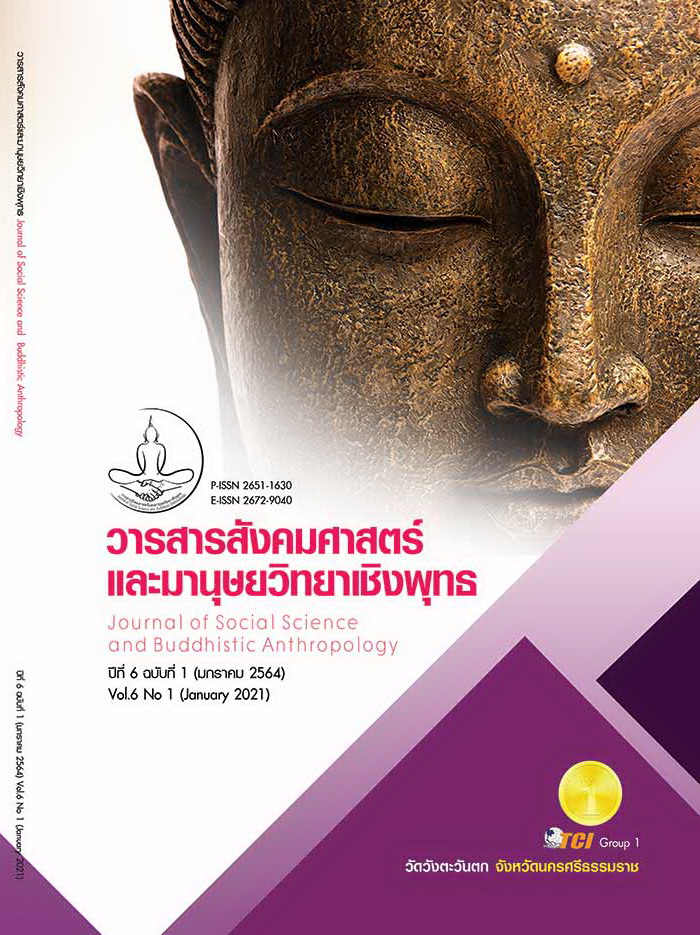GUIDELINES FOR HUMAN RESOURCE DEVELOPMENT FOR SUSTAINABLE GROWTH IN INDUSTRIAL BUSINESS
Keywords:
Structural Equation Modeling, Human Resource Development, Sustainable Growth, Industrial BusinessAbstract
The Objectives of this research article were to 1) investigate important levels of human- resource development for sustainable growth in industrial business, and 2) develop a structural equation model of human resource development for sustainable growth in the industrial business. This study employed both quantitative and qualitative research methods. The qualitative data was derived from a structured interview with 9 human resource development specialists, and the quantitative data was collected using a questionnaire survey with 500 samples of business owners or executives in the industrial business. The data was analyzed in frequency, percentage, mean, standard deviation, and structural equation model. The results revealed that the important level of the guidelines for human resource development for sustainable growth in industrial business was at high in overall. When considering in each dimension, including Organizational support, Internal process, Learning and growth, and Organizational engagement, the important level was at high in every dimension. The analysis of the structural equation model had value over the minimum criteria and consistent with the empirical data. It can conclude that 1) organizational support directly influence on learning and growth, and internal process at statistically significant levels of 0.001, 2) internal process directly influence on learning and growth and organizational engagement at statistically significant levels of 0.001, and 3) learning and growth directly influence on organizational engagement at statistically significant levels of 0.05.
References
กระทรวงอุตสาหกรรม. (2559). แผนแม่บทการเพิ่มประสิทธิภาพและผลิตภาพการผลิตของภาคอุตสาหกรรม พ.ศ. 2559-2564. เรียกใช้เมื่อ 3 มีนาคม 2560 จาก http://www.oie.go.th//assets/portals/1/fileups/2/files/Industrial%20Master%20Plan/productivity59_64_master_plan.pdf
กลุ่มสถิติแรงงาน สำนักงานสถิติแห่งชาติ. (2562). สรุปผลที่สำคัญ การสำรวจความต้องการพัฒนาขีดความสามารถของประชากร พ.ศ. 2562. เรียกใช้เมื่อ 5 มีนาคม 2562 จาก http://www.nso.go.th/sites/2014/DocLib13/ด้านสังคม/สาขาแรงงาน/Need_to_improve_capacity_of_population/2562/สรุปผลที่สำคัญ_2562.pdf
การนิคมอุตสาหกรรมแห่งประเทศไทย. (2562). รายงานประจำปี 2561. เรียกใช้เมื่อ 11 กันยายน 2561 จาก https://www.ieat.go.th/assets/uploads/cms/file/20191002170754905190686.pdf
ชัญภร เสริมศรี. (2558). ความสัมพันธ์ระหว่างการบริหารทรัพยากรมนุษย์กับความผูกพันต่อองค์การของบุคลากร บริษัทแห่งหนึ่ง ในเขตนิคมอุตสาหกรรมอมตะนคร จังหวัดชลบุรี. ใน วิทยานิพนธ์รัฐประศาสนศาสตรมหาบัณฑิต สาขาวิชาการบริหารทั่วไป. มหาวิทยาลัยบูรพา.
ชุติระ ระบอบ และคณะ. (2560). การพัฒนาอุตสาหกรรมไปสู่ยุค 4.0. วารสารธุรกิจปริทัศน์, 9(2), 249-267.
ธนิต โสรัตน์. (2559). อุตสาหกรรม 4.0 การปฏิวัติอุตสาหกรรมใหม่แห่งอนาคต. เรียกใช้เมื่อ 3 มีนาคม 2560 จาก http://tanitsorat.com/v2/showcontent.php?id=1071
ธาดา เคี่ยมทองคำ. (2561). แนวทางการพัฒนากำลังพลกองทัพอากาศเพื่อรองรับเทคโนโลยีอวกาศ. ใน รายงานการวิจัย. กองทัพอากาศ.
ศักชัย อรุณรัศมีเรือง และคณะ. (2562). นวัตกรรมและการยกระดับผลิตภาพอุตสาหกรรมใหม่ของประเทศไทย. วารสารธุรกิจปริทัศน์, 11(2), 232-246.
สำนักงานคณะกรรมการพัฒนาการเศรษฐกิจและสังคมแห่งชาติ. (2560). แผนพัฒนาเศรษฐกิจแห่งชาติฉบับที่ 12 (พศ. 2560-2564). เรียกใช้เมื่อ 5 มีนาคม 2560 จาก https://www.nesdc.go.th/ewt_dl_link.php?nid=6422
สำนักงานเลขาธิการสภาการศึกษา. (2561). ยุทธศาสตร์การพัฒนาและเสริมสร้างทรัพยากรมนุษย์. เรียกใช้เมื่อ 27 สิงหาคม 2563 จาก https://planning.tu.ac.th/uploads/ planning/pdf/Leaning/03_04062561.pdf
สำนักงานสถิติแห่งชาติ กระทรวงดิจิทัลเพื่อเศรษฐกิจและสังคม. (2562). การสำรวจความต้องการพัฒนาขีดความสามารถของประชากร พ.ศ. 2562. เรียกใช้เมื่อ 5 มีนาคม 2562 จาก http://www.nso.go.th/sites/2014/DocLib13/ด้านสังคม/สาขาแรงงาน/Need_to_improve_capacity_of_population/2562/Fullreport62.pdf
Ayop, H. (2018). The Application of Strategy Map in the Balanced Scorecard Implementation: A Case of a Public Organization. International Journal of Academic Research in Business and Social Sciences, 8(8), 725-737.
Karam, E. P., et al. (2017). Authentic Leadership and High-Performance Human Resource Practices: Implications for Work Engagement. Research in Personnel and Human Resources Management, 35(2017), 103-153.
Kura, K.M., et al. (2019). Linking Human Resource Development Practices to Counterproductive Work Behaviour: Does Employee Engagement Matter. Journal of African Business, 20(4), 472-488.
Kwon, K. & Park, J. (2019). The life cycle of employee engagement theory in HRD research. Advances in Developing Human Resources, 21(3), 352-370.
Matthew W.H., et al. (2017). Theoretical Foundations of Human Resource Development: Conceptual Visual Expansion. Retrieved March 23, 2019, from https://www.academia.edu/32800705/
Mishra, K. et al. (2014). Driving employee engagement: The expanded role of internal communications. Journal of Business Communication, 51(2), 183-202.
Mornata, C. & Cassar, I. (2018). The role of insiders and organizational support in the learning process of newcomers during organizational socialization. Journal of Workplace Learning , 30(7), 562-575.
Okoye, P.V.C.& Ezejiofor R. A. (2013). The Effect of Human Resources Development on Organizational Productivity. International Journal of Academic Research in Business and Social Sciences, 3(10), 250-268.
Rana, S. et al. (2016). Promoting self-directed learning in a learning organization: tools and practices. European Journal of Training and Development, 40(7), 470-489.
Saks, A. M. & Gruman, J. A. (2018). Socialization resources theory and newcomers’ work engagement. Career Development International, 23(1), 12-32.








